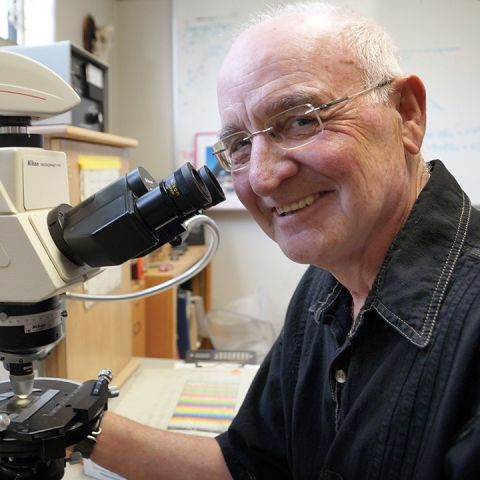Records from Platform Holly provide a glimpse of how petroleum production affects natural gas seeps
From oil rigs to tar seeps, it’s hard to miss the presence of petroleum around the Santa Barbara Channel. And the proximity of UC Santa Barbara has enabled scientists to investigate the interplay between the two processes releasing oil from underground: human enterprise and regional geology.
Emeritus Professor James Boles collected and analyzed decades of data on methane seeping from the seafloor southeast of Platform Holly, just offshore from Isla Vista. He and colleagues Grant Garven at Tufts University and Chris Peltonen at Beacon West Energy Group determined that production of oil and natural gas from the platform reduced natural methane seepage into the waters of the Santa Barbara Channel, confirming earlier regional studies. The findings appear in the journal Marine and Petroleum Geology.
“The gas production from Platform Holly has reduced natural seepage in this area over short time periods, resulting in a significant reduction in greenhouse gas emissions,” Boles said. “And hydrocarbon production can reduce natural seepage in areas with similar geologic settings.”
The petroleum deposits in the Santa Barbara Channel are relatively young compared to many of the world’s reserves. Sediment full of organic material was buried between 16 million and 5 million years ago, where time and temperature transformed the organic content into oil and gas. The sediment turned to shale, and deformation in the region folded and fractured the rock, creating pathways for fluids.
In many respects the South Ellwood Oil Field is typical of deposits in the Santa Barbara Channel. However, it is in relatively shallow water near the shore, and the modern marine sediment covering it is very thin, even nonexistent in some places. The oil has also accumulated close to the surface, only around a kilometer below the seabed. Since the region is heavily faulted, an abundance of oil and gas naturally seeps out along this stretch of the coast.
Humans have known about the oil deposits near Ellwood since time immemorial. Tar was used by the Chumash, and asphalt mines existed beneath the present UC Santa Barbara campus. The South Ellwood Oil Field was discovered onshore in the 1930s, but wasn’t extensively developed offshore until the 1960s. Platform Holly was installed in 1966, and had 30 active wells at any given time, which could extend up to 1.5 miles from the rig.
In 1982, the Atlantic Richfield Company (ARCO) installed two steel tents to capture methane seeping near Platform Holly. “The two steel pyramids, referred to as tents, are each 100 feet by 100 feet and weigh 350 tons,” Boles said. The installation cost the company $8 million, equivalent to around $25 million in 2023. Methane from the platform and the seep tents were piped into the Southern California gas supply.
The tents provided a unique chance to study natural seepage on the sea floor over a relatively large area. Boles seized this opportunity, and had the company install a measurement device on the gas flow line in 1994.
After combing through 20 years of data, the authors found that production at Platform Holly significantly reduced the amount of methane seeping into the tents. For example, production from a well drilled 1 kilometer beneath the tents immediately reduced the natural seepage. In contrast, the seepage increased when production ceased from that well. “This indicates a direct link between the oil reservoir and the natural seepage in the area,” Boles noted.
Other forces also influenced the amount of gas bubbling up from the depths. The authors discovered small changes in the rate of seepage corresponding to the tides. High tides suppressed seepage by about 8%, whereas low tides had the opposite effect.
Gas stopped flowing into the tents in the summer of 2013, when a new well was drilled just beneath them and produced large quantities of gas. Platform Holly ceased production altogether in 2015, and is currently being decommissioned. Although no methane is currently seeping into the tents, the area is still active. Since Holly shut down, long-time workers and supply boat crews have reported a considerable increase in gas seepage, which bubbles to the surface around the platform.
As a greenhouse gas, methane is about 25 times as potent as CO2 over the course of a century, so even small amounts can have an outsized warming effect. Given that methane would vent from this area anyway, harnessing the gas could actually reduce the greenhouse gas emissions from the South Ellwood Oil Field.
“It is important to understand that these natural seeps will continue,” Boles said. “In our area, it might be possible to capture additional natural methane seeps using sea floor devices.”
(805) 893-7220
harrisontasoff@ucsb.edu




